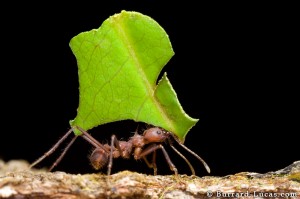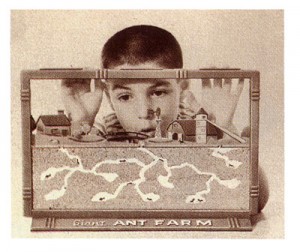For much of my childhood, ants meant one thing. Bites. Bites on my feet, hands and head. I was even so lucky as a kid to experience “ants in the pants” first hand. It was awful. Looking back, it wasn’t their fault. I was rolling, running, and rampaging through their colonies day in and day out. I was simply a kid that loved to experience the nature around me, and sometimes that nature responded to my love with ant bites.
Despite some negative experiences with ants, I did have an ant farm or two, being the pre-pubescent biologist that I was, and I took great care to provide my farms with all that I could. I loved watching their colony grow, seeing the varieties of pathways and caverns that they created, and jobs which they performed. While watching the colonies which I tended in my youth, I felt the rumblings of appreciate for their complex social systems and colony organization.
(invisibleagent.wordpress.com)
Now that I study insects and biology, I can more fully appreciate the ants for just how impressive and complex their colonies are. Ants in a colony fill a variety of roles, the most basic of which are probably the workers, the drones and the queen(s). Now for a short overview, the workers perform a variety of roles, including but not limited to foraging, defense and attack, tending to the queen, work on the nest. Much of this is done through chemical signals called pheromones. They can mark trails to food, announce if one ant is attacked or killed, and notify if a deceased nest-mate if decaying and in need of removal. The drones consist of only males, whose only purpose is to mate with the queen. Similarly, the queen, on occasion queens, exist to be mated with and to produce thousands and thousands of off-spring. If you want to learn more about ants in general, check out the… dare I say it? Wiki article on ants for some interesting and not-guaranteed-factual information.
All of the functions I just discussed are once again only the basic outline of ant social systems. I originally started looking into ants after finding information about the leafcutter ants (which we will definitely get to!), but I actually got quite excited learning about all the variation which exists within ant species that I’ll share just a few other surprising behaviors with you before we move on.
- Bulldog ants, which are very large, hunt alone, unlike their other eusocial family-mates who primarily have large numbers of foragers which work together, using their eyes to find and kill prey.
- Certain species will raid other ant colonies, not only to eat gathered food/offspring/ants, but to save larvae and raise them as slave worker ants. However, the Temnothorax ants have been seen to counter this behavior by killing slave making females in their pupae stage.
- Other ant species will tend to aphids, small insects which feed off of plant phloem, feeding off of their honeydew, and protecting them in a symbiotic relationship.
- Some ants have even developed traps for larger insects, ambushing them, biting their legs and antennae, as they pass over a net of plant fibers glued together by a specially cultivated fungus. How awesome (and terrifying) is that?
All of these impressive and specialized types of ants build up a lot of expectations for the little leaf cutter ant that I want to discuss, any although they mind not be as glamorous as trap-laying ants, I still think they are truly something to behold. Prepare yourself for the leaf cutter ant.
What is so cool about ants that eat leaves? Nothing, these ants don’t eat leaves. They cut leaves, so many leaves in fact that they are found to be the largest harvester of plant biomass, more so than any herbivores or other insects. With highly diverse workers, task specialization is very important, the bigger ants that act as soldiers and foragers, while the smaller ants have the pleasure of tending the gardens. That’s right; these ants collect leaves only to cultivate a fungus farm. The fungus uses the biomass they collect as substrate and the ants then feed off of gongylidia which the fungi sprout.
A variety of even more specialized roles are required to provide for the garden, tend to it, harvest it, and dispose of refuse so that neither the ants not fungus will have hygiene or pathogen concerns. The ants even react when biomass negatively affects the fungus and no longer provide such biomass as substrate. The ant’s only food source is the fungus, and the fungus only exists within ant colonies, meaning they have obligate dependence on one another. In fact the ant genome has changed to make it less adept at feeding off of anything but its farmed fungus. As a result the queen will even bring with her some of the fungus so that she might start her own garden upon the founding of her colony.
Next time you see a row of ants carrying little scraps of leaves, you’ll know that these are not the “ants in the pants” fire ants you so fear. They are workers that fight every day to provide as much as they can for the biggest and most bountiful farms that exist beneath our feet. Somewhere underground their sisters are tending to the harvest, flourishing thanks to a diverse set of roles to fulfill all the functions of the colony, and benefitting from a complex and beautiful mutualistic relationship between the leaf cutter ants and their farming fungus. (http://www.plosgenetics.org/article/info%3Adoi%2F10.1371%2Fjournal.pgen.1002007

